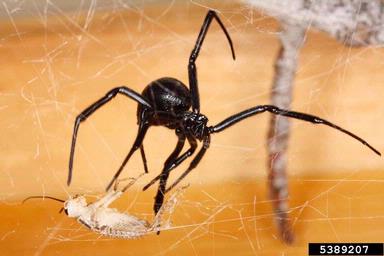Nutrition
The Black Widow Spider is a carnivorous spider. It often preys on insects such as wood lice, diplopods, chilopods, and arachnids. Although these are the most common choices of prey, Lactodectus sp. have been known to prey on many different types of victims, from large to small, fast to slow, and poisonous and non-poisonous. They will eat anything that they can successfully catch and then kill. This usually includes insects, but can sometimes include small reptiles, birds, and mammals.
When an insect lands on the Black
Widow’s web, the spider can feel the vibrations and will immediately
start to wrap its prey with its silk webbing. The Latrodectus sp.
will then bite its prey and inject venom into the insect with
its fangs. This venom is 15 times stronger than that of a
rattlesnake, so it works very quickly. At this point, the spider
drags the prey to its sheltered home. When the Black Widow’s victim
stops moving, the spider then uses its cheliceral teeth to chew and
mash up the original wound site. After that, this site is used for
the Latrodectus sp. to pour its digestive enzymes in to. The
spider then sucks up the food within its prey’s body. The whole
digestive process takes place outside of the spider's body.
The Black Widow has the ability to consume a
lot of food, but can also go for long periods of time without it. In
lab experiments scientists have found that on average a spider can
survive three to four months without food. One spider, although
greatly weakened, survived 9 months before being replenished and
brought back to health. This showed that the Latrodectus sp.
can acclimate to almost any food abundance.
